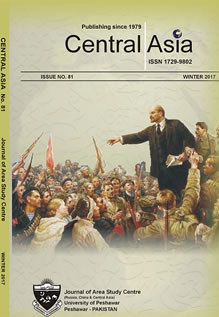October Revolution and Soviet Class Struggle Policy in Kyrgyzstan
DOI:
https://doi.org/10.54418/ca-81.100Keywords:
October Revolution, Kyrgyzstan, Class Struggle, Tsarist RussiaAbstract
In the middle of the XIX century, the territory of contemporary Kyrgyzstan was conquered by the Tsarist Russia. Later, in 1917, as a result of the October Revolution, the Tsarist regime was replaced by the Soviet rule. In the territory of Kyrgyzstan, it was established firstly in the southern and western regions of the country, such as Suluktu and Kyzyl-Kiya, Osh and Talas, where the largest industrial enterprises, mines, railway junctions and most of the workers and soldiers were concentrated. However, already by the mid 1918, the Soviet government managed to spread its power to the entire region of Kyrgyzstan.
In 1924, the Turkestan Autonomous Soviet Socialist Republic, established on April 30, 1918, was reorganized into a new administrative division. As the part of the Russian Soviet Federative Socialist Republic (RSFSR), on October 24, 1924 the Kara Kyrgyz Autonomous Region was formed. On May 25, 1925 the Kara Kyrgyz Autonomous Region was renamed into the Kyrgyz Autonomous Region. Then on February 01, 1926 it was restructured into the Kyrgyz Autonomous Soviet Socialist Republic. On December 05, 1936 it became a separate constituent republic of the Union of the Soviet Socialist Republics (USSR) known as the Kyrgyz Soviet Socialist Republic. Along with other 15 Soviet Socialist states, Kyrgyzstan had been the member of the USSR for about 70 years, from 1919 till 1991.
The current paper focuses on the processes of social transformation under the Soviet regime, especially the implementation of class struggle policy and its impact on Kyrgyzstan. In comparison with the interventions from the Tsarist Russia, the social transformation process undertaken under the Soviet system was quite different. In the territory of the Kyrgyz traditional society, the Tsarist Russia made only some social reorganization, but the Soviets brought radical changes in to the socio-political organizations of the Kyrgyz people. The paper seeks to understand how the Soviet Union tried to reconstruct the Kyrgyz society during the 1920s and 1930s. In addition, the paper will analyze the methods and mechanisms of the social transformation processes and the measures used by the Soviet government in their socio-political ‘battles’ against the local elites, and the influence of the new system on the existing socio-economic stratification in the context of the Kyrgyz society. During the Soviet period the prevalent scientific vision about the major historical events of the time was based on the Communist ideology. Therefore, the main aim of the paper is to analyze and describe an objective overview of the history of Soviet class struggle policy. The paper is based on the research of local archival documents, published sources and oral materials.










